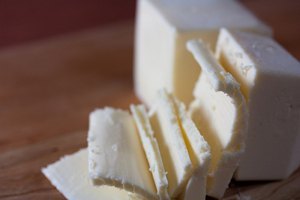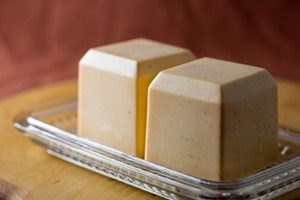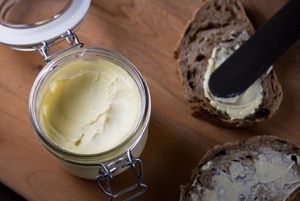Vegan Pistachio Meringue Cookies
6
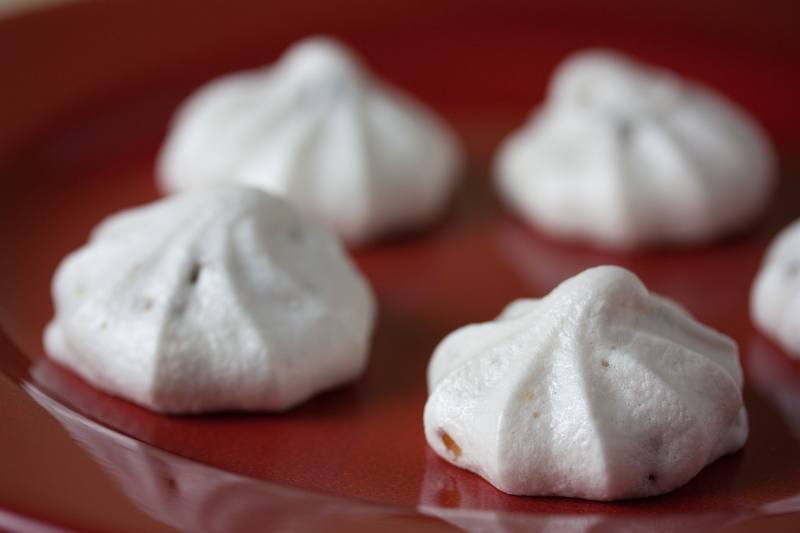
I set out to into the annals of food science to create a Vegan Meringue recipe. I ended up uncovering a treasure trove of information that can be applied to other vegan baking applications.
Meringue is a perfect example of how eggs act in traditional baking and how difficult it often is to replace them. When an egg is beaten extensively the proteins contained within it unravel and bind together like rebar in concrete, air bubbles are trapped and ingredients are easily able to coexist together regardless of moisture content. Traditional meringue involves beating an egg mixture until it has incorporated a large volume of air bubbles, strengthening this mixture so it holds it's shape, adding sweeteners and flavorings then piping and baking it so it slightly leavens and dries to a crisp. Perfectly baked meringue has a delicate crispness that dissolves in your mouth and leaves behind a slightly chewy but not gummy center. There's nothing earthy and natural about this meringue. Order your hard to find ingredients online, put on your extra nerdy glasses and let's make vegan meringue!
Stark Discoveries in Starch
How do you remove such a versatile ingredient such as an egg and replace it with something else when making meringue? After all, the majority of a traditional meringue is from the egg. No flax meal here; I knew that a certain ratio of starches, proteins and gums were the only way to go. I decided to start first with the starch.Vegetable starches come in two main forms: root based such as arrowroot, tapioca and potato starch and grain based such as corn starch, wheat starch and rice starch. Root based starches have higher amounts of amylopectin which, when activated by heat, gel up into a thick, moist goop. Grain based starch has a higher amount of amylose which dries to a tough, rigid form after being activated by heat. Have you ever wondered why people often make wheat paste to glue flyers on outdoor surfaces or why books traditionally have been bound by wheat based glue? The proof is in the pudding! I performed tests with corn starch, wheat starch, tapioca starch and arrowroot starch where I placed 2 Tablespoons of each in a small sauce pan with 1 cup of water and activated the mixture until it was 250F (121C). I then transferred the mixture to a bowl, waited for each batch of starch to cool to room temperature and poked it with my finger to observe firmness. The high amount of amylose in the corn and wheat starches made them the clear winners for what I was going after: a dense, firm gel. No wonder corn starch is the go-to ingredient when breading or crusting things like tofu, tempeh or seitan. The higher amount of amylopectin in the arrowroot and tapioca starch made them too gelatinous to be of any use in a meringue.
Next I had to ensure the starch I was using was as flavor neutral as possible. Since I was planning on using a large amount of starch this was extremely important. I taste tested the corn starch and was surprised to get an intense burst of bitter soapy flavor. I then tasted the wheat starch and did not detect a large amount of off-flavor. Too bad wheat starch is a relatively exotic ingredient. I promptly ordered a large batch of it on the internet. Wheat starch has just secured a permanent spot in my kitchen for future baking adventures.
Building Structure in Vegan Meringue
Beating activated wheat starch didn't change the mixture's consistency at all. Beating unactivated wheat starch in water produced a basic sea foam consistency but failed to develop further; I needed to trap more air bubbles. Xanthan gum is an amazing polysaccharide produced by fermenting a bacteria, Xanthomonas campestris on corn sugar. This is the same bacteria that produces the slimy substance on the vegetables that are starting to go bad in your refrigerator. The difference is that xanthan gum is produced in an otherwise sterile environment so there's no risk of contamination or questionable black slime. Xanthan gum is extremely versatile because it enables ingredients to mix together well, hold onto air bubbles and it provides structure, making it great for foams. Very few vegan ingredients can do all of these things in one fell swoop. After beating a bit to the wheat starch mixture I was soon rewarded with a bowlful of fluffy foam.I then beat in soy protein isolate to reinforce the structure of the foam. As mentioned above, protein in baking acts like rebar in concrete to bind and secure structure. Cream of tartar was then beaten in to encourage the proteins to further unravel and bind. When making meringue you want to look for what's called the bird's beak which refers to the shape of the foam when you take out one of the beaters and hold it horizontally. I knew I was going in the right direction when I pulled out the beaters to find the bird's beak staring me in the face! I flapped my wings with delight and let out a loud squawk that my neighbors hopefully didn't hear.
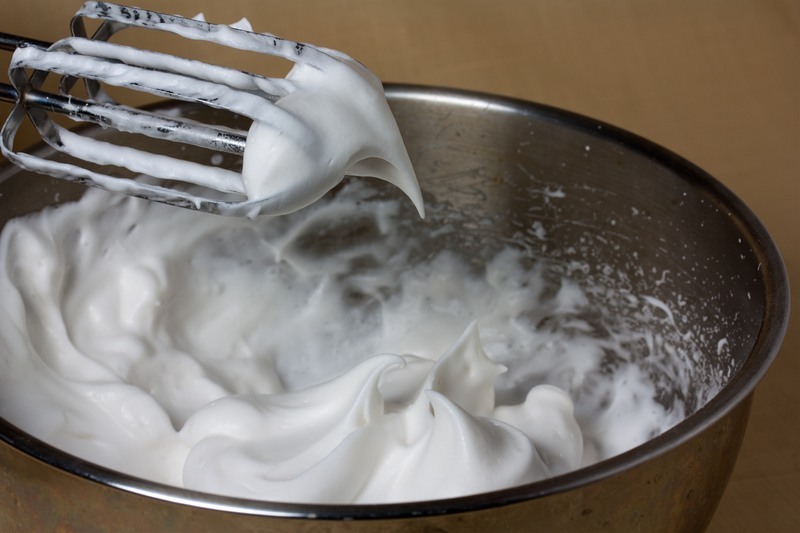
Meringue Methods
After beating this mixture until it had the optimal ratio of foam to structure I added the sugar and flavorings. This meringue is based on the French method where sugar is beaten in, opposed to the Italian method where simple syrup is beaten in. I got significantly better results with the French method because the simple syrup in the Italian method tended to weigh the foam down excessively.I've also seen the French method done with confectioner's sugar but in testing I got identical results with granulated sugar so I opted for that route. Confectioner's sugar also contains potato starch which I wanted to avoid introducing into the equation.
Enhancing Flavor
Since traditional meringue is just sweetened dried egg foam it has a tendency to taste bland. Adding caramel sauce and toasted pistachios added much needed flavor depth without inhibiting the consistency of the meringue. After making countless batches using different ratios of ingredients, varying degrees of temperature and an array of different baking times I settled with the recipe below. This meringue is baked about twice as long as traditional meringue because the xanthan gum is so effective at holding onto moisture it needs more time to allow it to dry out. Higher baking temperatures and larger cookie sizes saw the introduction of unwanted large air bubbles in the meringue cookies.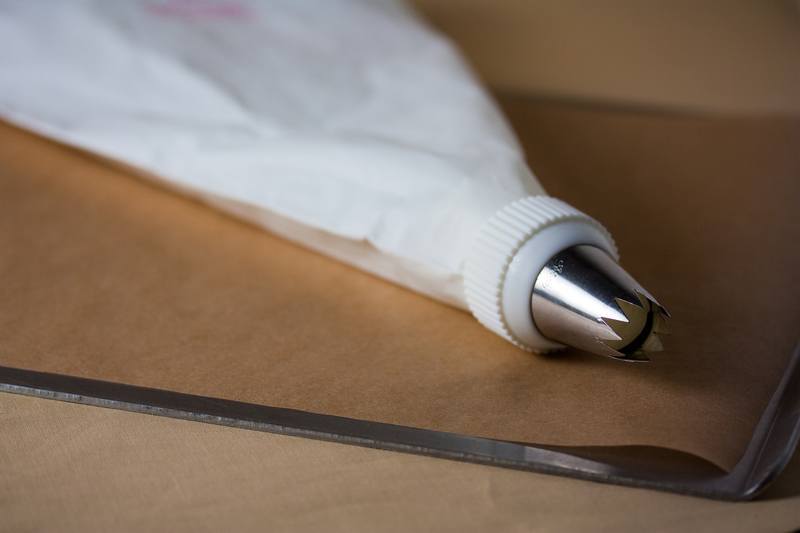
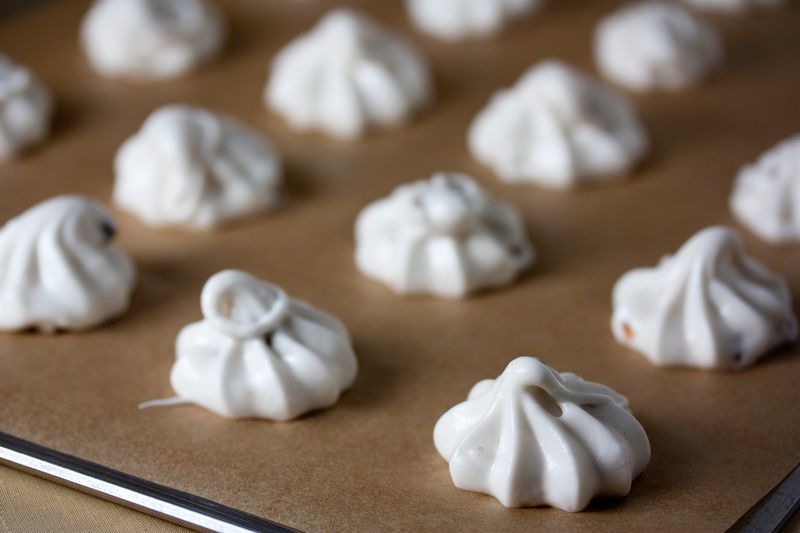
I attempted to use this recipe and method as a base for angel food cake but so far have been unsuccessful as of this writing, mainly due to the excessive moisture that the xanthan gum holds onto before needing to be baked out.
Find more French-style recipes on Veganbaking.net
Vegan Pistachio Meringue Cookie Recipe
¾ cup water¼ cup wheat starch
1 teaspoon xanthan gum
2 Tablespoons soy protein isolate
¼ teaspoon cream of tartar
1 cup sugar
¾ teaspoon vanilla extract
2 Tablespoons Vegan Golden Caramel Sauce or Easy Vegan Caramel Sauce
1/3 cup toasted pistachios chopped into ¼ inch pieces (chopped in half)
1) Toast the pistachios and prepare your baking sheets
Toast the pistachios. Preheat your oven to 200F (93C). Line two baking sheets with parchment paper.Learn more about how to toast nuts.



